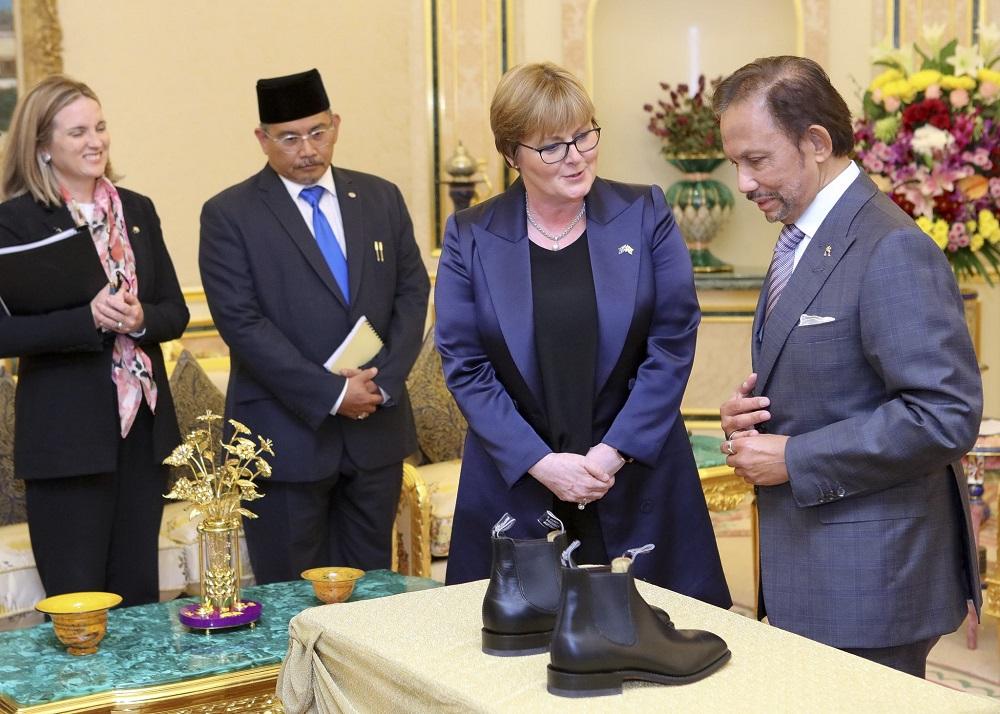What’s in a visit to Brunei?
Posted By Euan Graham on October 23, 2020 @ 14:30

An Australian ministerial visit to Brunei Darussalam normally triggers little strategic interest. But there may be more than meets the eye to Defence Minister Linda Reynolds’s meeting this week with Sultan Hassanal Bolkiah, sandwiched in between visits to Singapore and the Philippines. The fact that the visit took place during a pandemic, when only essential travel is meant to happen, is prima facie evidence that Canberra sees the defence relationship with Brunei as worth investing in. Why?
Brunei and Australia have had a memorandum of understanding on defence cooperation since 1999, providing a foundation for a low-key bilateral defence relationship. Brunei’s traditional and primary defence partner is the UK, symbolised by a resident Gurkha battalion [1] and associated British Army units, hosted at the Sultan’s expense. Reynolds’s pre-departure announcement offered little indication of a substantive agenda, other than that Brunei will take over the ASEAN helm from Vietnam next year, while noting that Australia and Brunei are current co-chairs of the ASEAN Defence Ministers’ Meeting Plus experts working group on military medicine. Not insignificant, but not an obvious case for ministerial face time.
Yet momentum has been quietly mounting in the defence relationship this year, including the first visit by an Australian submarine [2] in March, which was accompanied by Chief of Navy Mike Noonan. In July, a Royal Australian Air Force P-8A Poseidon flew in [3] for a bilateral drill (‘Exercise Penguin’, incongruously) with Brunei’s armed forces, which lack significant fixed-wing assets of their own. In August, the Royal Australian Navy and Royal Brunei Navy held a passage exercise on their way to Exercise RIMPAC, off Hawaii.
According to Reynolds’s post-visit statement [4], Brunei and Australia ‘share common interests in a secure, stable and open Indo-Pacific’. That may be so, but I see Australia’s recently invigorated interest in the sultanate as part of a broader effort to shore up Canberra’s access to maritime Southeast Asia and the South China Sea beyond its traditional partners and operating locations on the Malay Peninsula. This is reinforced by the inclusion of the Philippines on the defence minister’s travel itinerary. Australia’s military and defence relationship with the Philippines has shallow roots compared with Five Power Defence Arrangements [5] (FPDA) partners Malaysia and Singapore, but an enhanced defence cooperation program [6] has been in place since December 2019. The Australian Defence Force has deployed naval [7] and air [8] assets, with a significant training component, to the Philippines. Counterterrorism was the initial impetus, but Australia is also interested in the revival of Subic Bay as a prime location from which to sustain a forward naval presence in the South China Sea.
Malaysia, although not on Reynolds’s itinerary, remains arguably Australia’s most important and longstanding defence access partner in the subregion. Australia continues to conduct regular maritime surveillance flights over the South China Sea from Butterworth air base, near Penang, under arrangements dating back to 1980. RAAF aircraft enjoy superior access than US Navy P-8As which occasionally stage out of Malaysia.
Singapore, also in the FPDA and a comprehensive strategic partner in its own right, is another important node for Australia and officially described in the 2016 defence white paper as Australia’s most advanced defence interlocutor in Southeast Asia. Australia holds a reciprocal significance [9] for Singapore as host to some of the island republic’s most important overseas training grounds and military exercises. Access is a two-way street, therefore, but cannot be guaranteed in extremis.
It makes sense for Canberra to negotiate broader access arrangements that better encompass the South China Sea and reduce risks that arise from being beholden to one or two countries for basing and logistics support that are critical to forward ADF operations in Southeast Asia. This would be consistent with the defence strategic update [10] and its heightened focus on defending Southeast Asia as part of Australia’s core strategic environment. It can be inferred from the update that Canberra intends to maintain a naval and air presence in and around the South China Sea. This has been borne out by a regular tempo of ADF deployments despite the pandemic and a corresponding intensification of coordinated bilateral and trilateral deployments with the US Navy and Japan’s Maritime Self-Defense Force. Australia’s impending participation in the Malabar naval exercises with India, Japan and the US stands to add a buttressing, quadrilateral dimension to this, though the drills themselves will remain centred on the Indian Ocean.
Australia’s defence relationship with Brunei is unlikely to ramp up dramatically. That’s not realistic. But Reynolds’s visit suggests that Canberra is doing what it can to pursue a more distributed network of access arrangements across maritime Southeast Asia. This is in Australia’s strategic interest, in a subregion where most states are actively hedging and willing partners are in limited supply, as Indonesia has recently reminded [11] the United States. As is often the watchword these days, it makes sense to diversify one’s portfolio.
The same logic applies to Brunei, as a reluctant quasi-claimant in the South China Sea disputes. Until now, its closest defence partners have been the UK and Singapore. But as China encroaches ever closer in the South China Sea, potentially threatening Brunei’s offshore energy reserves and economic future, closer defence ties with Australia could be a seen as a prudent and calibrated addition to its own portfolio of security partners.
Article printed from The Strategist: https://aspistrategist.ru
URL to article: /whats-in-a-visit-to-brunei/
URLs in this post:
[1] Gurkha battalion: https://www.army.mod.uk/deployments/brunei/
[2] submarine: https://thediplomat.com/2020/03/first-submarine-visit-highlights-australia-brunei-defense-ties/
[3] flew in: https://adbr.com.au/indo-pacific-regional-news-wrap-3/
[4] post-visit statement: https://www.minister.defence.gov.au/minister/lreynolds/media-releases/deepening-relations-brunei-darussalam
[5] Five Power Defence Arrangements: /a-strategist-retrospective-the-future-of-the-five-power-defence-arrangement/
[6] enhanced defence cooperation program: https://www.defence.gov.au/operations/opauguryphilippines/
[7] naval: https://news.navy.gov.au/en/Jun2019/Operations/5255/Navy-trainers-support-Philippines-in-maritime-patrol-mission.htm#.X5EZEUIzbBI
[8] air: https://www.theguardian.com/world/2017/jun/23/australian-p-3-orion-planes-to-help-fight-islamic-state-affiliated-groups-in-philippines
[9] significance: https://www.lowyinstitute.org/publications/lion-and-kangaroo
[10] defence strategic update: https://www.defence.gov.au/strategicupdate-2020/
[11] reminded: https://www.channelnewsasia.com/news/asia/indonesia-united-states-host-spy-planes-china-13320186
Click here to print.